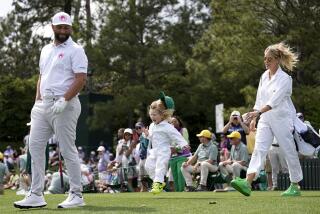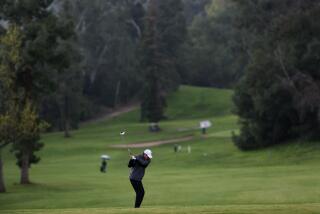Things Not Clicking at Bob Hope Classic
- Share via
PALM DESERT — Here’s what you will see beginning today in the first round of the $2.3-million Bob Hope Chrysler Classic:
John Cook, the defending champion, plus John Daly and David Duval, and such celebrities as Richard Dreyfuss, Samuel L. Jackson and Oscar De La Hoya.
Now, here’s what you won’t see:
Cameras.
And you have Tiger Woods to thank for it.
For the first time in the 39-year history of the Hope, spectators can’t bring cameras to the courses.
What a development. That perfect picture you want to take of, say, Dreyfuss or somebody trying to find the ball he hit under a folding chair? It’s a no-no now, all because of a new PGA Tour rule in effect for 1998.
How did we get from the salary cap to the lens cap? Blame the Tiger Rules.
Actually, for purposes of categorizing the camera ban, it belongs under the growing list of new PGA Tour ordinances inspired by the emergence of Woods. They are the so-called Tiger Rules.
For instance, media have been banned from tee boxes of all PGA Tour events since the second round of last year’s MasterCard Colonial in Fort Worth. That rule was instituted because there were so many photographers and reporters following Woods’ group, it was judged to be a distraction.
Rather than ration the number, the tour cut out everyone. So in a flash, the reporters and writers in the tee areas went the way of the fans’ cameras.
As far as fans taking pictures, the tour isn’t changing its mind about saying no. It’s positive about negatives.
At least the Hope isn’t going this thing alone. The camera ban is being applied for the first time to the three pro-am events--the Hope, Pebble Beach and Phoenix. Woods isn’t playing the Hope, but he has entered Pebble Beach. A PGA Tour rule prohibiting spectators from bringing cameras to regular tournaments has been in effect for years, so the competition isn’t affected.
Dave Lancer, the PGA Tour’s director of information, said the idea for the camera rule was to bring the pro-ams in line with other tour events.
Oh, and there’s another reason.
“People want to take pictures of celebrities, but somebody does it to Tiger Woods in his backswing on the 18th hole, then we’ve got a problem,” Lancer said.
There were plenty of problems involving Woods and cameras last year at the AT&T; Pebble Beach National Pro-Am. It was there that Woods and playing partner Kevin Costner braved more flashing strobes and clicking shutters than there were trees in the Del Monte Forest.
Woods complained about the camera angle, so it’s gone. Simple as that.
“It just brought it to a head,” Lancer said.
The photography issue seems to have captured the attention of the PGA Tour. This year, the tour has done away with professional photographers’ armbands, good for the week of the tournament, and instead chosen to issue large stickers color-coded for each day and passed out daily by tour media officials.
In addition, the tour has tightened the credentialing process for photographers at tournaments, insisting that photographers must represent a news agency or must be assigned to a story by a publication in order to be considered for credentials.
For freelance photographers, this is not good news. The tour’s position is that it needs to better police this area and needs to protect the players from the possibility that their likenesses would be sold without prior approval.
Art Seitz, who shoots for Paris-based Gamma and is regarded as one of the top sports-celebrity photographers in the world, said “shooters” should be valued at pro-ams.
“It ought to be ‘Thanks for coming, what can we do for you?’ ” said Seitz, who has shot Pebble Beach six times. “Photogs aren’t looking for autographs, they aren’t dilettantes. Besides, at pro-ams, they should expect and want celebrity photographers. At the Pebble Beach, with Bill Murray, he’s revitalized that event. Photographs of him coming out of it probably increased attendance 10%.”
By the way, Seitz said he has never laid eyes on Woods. He has rolls of film of Murray, Costner and Clint Eastwood, though.
Meanwhile, amateur photographers will be the first to feel the brunt of the Tiger Rules. Since the Hope is the first of the three pro-am events to try the no-camera rule, no one is quite sure what to expect.
Precautions have been taken, though, such as establishing no-camera checkpoints, reminding fans at the tram service areas and putting up signs.
Fans whose cameras are confiscated will be given a claim check and may pick them up at the end of the round.
Mike Milthorpe, the tournament director, said the Hope has had an unwritten ban on cameras in the past but never enforced it. Milthorpe said the fans usually have been more interested in taking pictures of the celebrities than the pros and that most of the spectators with cameras stay at the course with the celebrity field, which rotates to a different course every day.
That should make the camera ban a little easier to enforce, but Milthorpe isn’t sure.
“Obviously, if it’s cold in the morning, people are going to be wearing big jackets and people are gonna get cameras in,” he said. “But hopefully, they’ll read the signs.”
Maybe the ban will amount to nothing, after all. But no cameras at the Hope? Can’t picture it? Better start right now.
More to Read
Go beyond the scoreboard
Get the latest on L.A.'s teams in the daily Sports Report newsletter.
You may occasionally receive promotional content from the Los Angeles Times.










